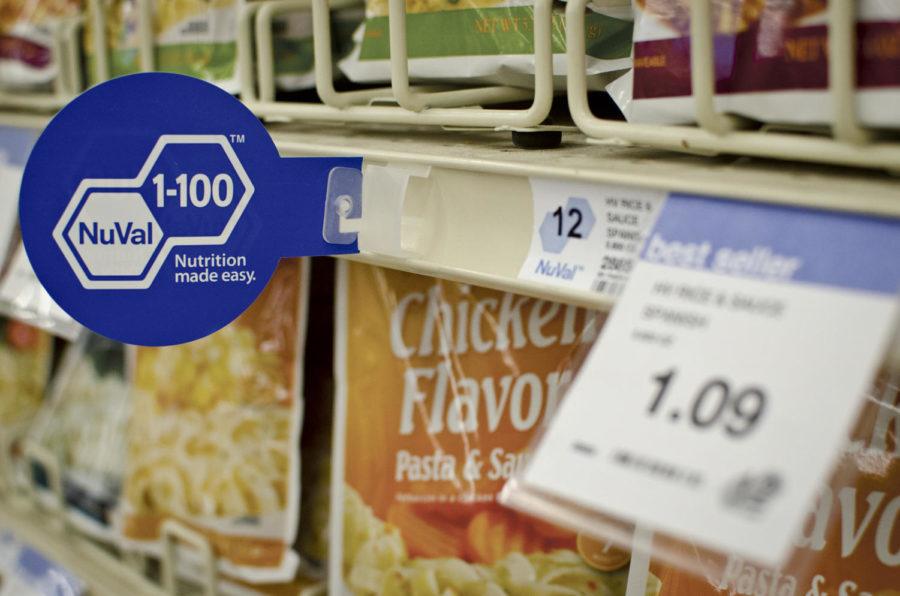Knowing how to read nutrition labels can help cut calories, become healthier
Photo: David Derong/Iowa State Daily
HyVee’s numeric NuVal labeling system makes it easier for shoppers to compare and contrast the nutritional value of what they are shopping for. The higher the number listed on the shelving tag, the more nutritious the item is.
January 29, 2012
Nutrition labels do not have to be as hard to understand as a neuroscience textbook. In fact, once one knows what to look for, nutrition labels can be crucial in helping one choose healthy options when grocery shopping.
“I wish I was more knowledgeable about products,” said Jake Rysted, junior in psychology. “When I look at [nutrition labels], they’re all just numbers to me.”
When looking at a nutrition label, one should first note the serving size, said Ruth Litchfield, ISU professor of food science and human nutrition.
“If there are 2.5 servings in a 20-ounce bottle of pop, you need to multiply all of those values by 2.5,” Litchfield said. “How many people drink just one serving of a bottle of pop?”
Litchfield also recommended that people look at how much sugar is in what they are about to consume. She said people should keep in mind that four grams of sugar is one teaspoon.
“The recommendation is six to nine teaspoons of sugar per day,” Litchfield said. “A lot of people are consuming 20 to 22 teaspoons of added sugar a day. This added sugar is mostly through processing.”
People often become overweight or obese not by eating too much fat or protein but from eating too much sugar, Litchfield said.
“Sugar is a source of calories, especially added sugar,” Litchfield said. “Calories is the name of the game for obesity.”
Litchfield warned shoppers should be aware of food items deemed “healthy” but are actually loaded with sugar and calories.
“There’s one bottle of green tea that if you drink it, you are consuming the same amount of sugar as four pieces of Sara Lee cherry pie,” she said.
For people who want to satisfy their sugar craving, they should eat some hard candy, Litchfield said. She explained that hard candy is better than chocolate because chocolate has calories from both the sugar and from the milk.
“If someone wants chocolate, they should eat something with chocolate coating — not a solid chocolate bar,” Litchfield said.
While sugar is a major contributor to calories in food, the amount of fat in a product should also not be ignored, Litchfield said.
There are three different types of fat: saturated, unsaturated and trans. According to WebMD, unsaturated fat is liquid at room temperature and comes mostly from plant oils. This kind of fat has been shown to possibly improve cholesterol levels.
Saturated fat is solid at room temperature and is mostly in animal products such as milk, cheese and meat. Saturated fat can increase cholesterol, according to WebMD.
Trans fat is produced through a process called hydrogenation, which causes the fat to be harder at room temperature and have a longer shelf life. The website said that trans fat is often in processed food, snack foods, cookies, some margarines and dressings, and food made with shortening or partially hydrogenated oils.
“It was found through research that the trans fat produced is just as undesirable or even more undesirable than saturated fat,” Litchfield said. “Now you’ll notice a lot of products saying that they don’t have any trans fat.”
Litchfield advised that people also be aware of what they drink during the day. She explained that there are many drinks on the market that are “calorie-laden.”
While water is the ideal choice of drink, if a person wants something with more flavor, they should look for drinks that use a sugar substitute, Litchfield said.
“I know some people have concern about using sugar substitute,” Litchfield said. “But if you use [sugar substitutes] in moderation, they are just fine.”
For a quick and healthy meal, Litchfield advised that people choose pasta. She also recommended that people mix veggies with some leftover meat and serve that over rice to make a stir fry dish.
“Those are just some quick and easy things to make,” she said. “And you’re not going to get into high levels of sodium like you would if you ate microwave meals.”







